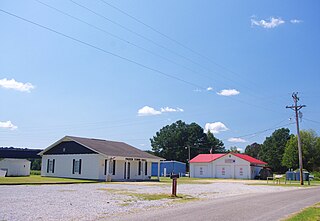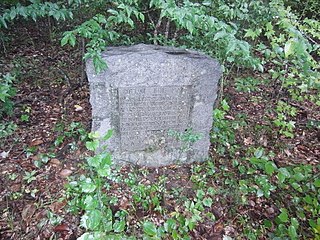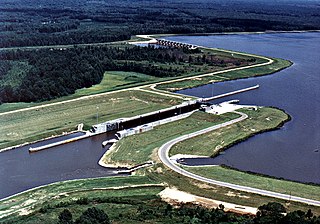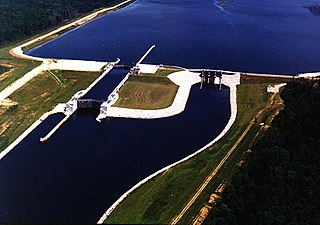
Tishomingo County is a county located in the northeastern corner of the U.S. state of Mississippi. As of the 2020 census, the population was 18,850. Its county seat is Iuka.

Paden is a village in Tishomingo County, Mississippi, United States. The population was 116 at the 2010 census.

The Tennessee River is the largest tributary of the Ohio River. It is approximately 652 miles (1,049 km) long and is located in the southeastern United States in the Tennessee Valley. The river was once popularly known as the Cherokee River, among other names, as the Cherokee people had their homelands along its banks, especially in what are now East Tennessee and northern Alabama. Additionally, its tributary, the Little Tennessee River, flows into it from Western North Carolina and northeastern Georgia, where the river also was bordered by numerous Cherokee towns. Its current name is derived from the Cherokee town, Tanasi, which was located on the Tennessee side of the Appalachian Mountains.

Jamie Lloyd Whitten was an American politician and member of the Democratic Party who represented his native state of Mississippi in the United States House of Representatives from 1941 to 1995. He was at the time of his departure the longest-serving U.S. Representative ever. From 1979 to 1995, he was Dean of the U.S. House of Representatives. He is the longest-serving member of Congress ever from Mississippi. He was a New Deal liberal on economic matters, and took a leading role in Congress in forming national policy and spending regarding agriculture. Whitten was the last remaining member of Congress to have served during the FDR administration.

The Tombigbee River is a tributary of the Mobile River, approximately 200 mi (325 km) long, in the U.S. states of Mississippi and Alabama. Together with the Alabama, it merges to form the short Mobile River before the latter empties into Mobile Bay on the Gulf of Mexico. The Tombigbee watershed encompasses much of the rural coastal plain of western Alabama and northeastern Mississippi, flowing generally southward. The river provides one of the principal routes of commercial navigation in the southern United States, as it is navigable along much of its length through locks and connected in its upper reaches to the Tennessee River via the Tennessee-Tombigbee Waterway.

The Mobile River is located in southern Alabama in the United States. Formed out of the confluence of the Tombigbee and Alabama rivers, the approximately 45-mile-long (72 km) river drains an area of 44,000 square miles (110,000 km2) of Alabama, with a watershed extending into Mississippi, Georgia, and Tennessee. Its drainage basin is the fourth-largest of primary stream drainage basins entirely in the United States. The river has historically provided the principal navigational access for Alabama. Since construction of the Tennessee-Tombigbee Waterway, it also provides an alternative route into the Ohio River watershed.

Cotton Gin Port is a ghost town in Monroe County, Mississippi, United States.

The Tennessee–Tombigbee Waterway is a 234-mile (377 km) artificial U.S. waterway built in the 20th century from the Tennessee River to the junction of the Black Warrior-Tombigbee River system near Demopolis, Alabama. The Tennessee–Tombigbee Waterway links commercial navigation from the nation's midsection to the Gulf of Mexico. The major features of the waterway are 234 miles (377 km) of navigation channels, a 175-foot-deep (53 m) cut between the watersheds of the Tombigbee and Tennessee rivers, and ten locks and dams. The locks are 9 by 110 by 600 feet, the same dimension as those on the Mississippi above Lock and Dam 26 at Alton, Illinois. Under construction for 12 years by the U.S. Army Corps of Engineers, the Tennessee–Tombigbee Waterway was completed in December 1984 at a total cost of nearly $2 billion.

The John C. Stennis Lock and Dam, formerly named Columbus Lock and Dam, is one of four lock and dam structures on the Tennessee-Tombigbee Waterway that generally lie along the original course of the Tombigbee River. It is located near Columbus, Mississippi, and impounds Columbus Lake. It is named for longtime U.S. Senator from Mississippi, John C. Stennis.

The Aberdeen Lock and Dam is one of four lock and dam structures on the Tennessee-Tombigbee Waterway that generally lie along the original course of the Tombigbee River. It is located east of Aberdeen in Monroe County, Mississippi, and impounds Aberdeen Lake.

The Tom Bevill Lock and Dam, formerly named Aliceville Lock and Dam and "Memphis Lock and Dam", is one of four lock and dam structures on the Tennessee-Tombigbee Waterway that generally lie along the original course of the Tombigbee River. It is located near Aliceville, Alabama and impounds Aliceville Lake. It is named for Tom Bevill, a proponent of the Tenn-Tom.

The Howell Heflin Lock and Dam, formerly Gainesville Lock and Dam, is one of four lock and dam structures on the Tennessee-Tombigbee Waterway that generally lie along the original course of the Tombigbee River. It is located near Gainesville, Alabama, and impounds Gainesville Lake. It is named for Howell Heflin, a former United States Senator from Alabama.

The Glover Wilkins Lock is a lock of the Tennessee-Tombigbee Waterway. It is located close to Smithville, Mississippi. It was named for Glover Wilkins.

The Fulton Lock is a lock and dam on the Tennessee-Tombigbee Waterway.

The John Rankin Lock is part of the Tennessee-Tombigbee Waterway. It is located in Itawamba County, Mississippi, approximately 6 miles (9.7 km) north of Fulton.

The Gillespie V. Montgomery Lock is part of the Tennessee-Tombigbee Waterway. It is located in north Itawamba County, Mississippi, close to the Prentiss County line.

Bay Springs Lake is a reservoir on the Tennessee-Tombigbee Waterway in the U.S. state of Mississippi. It is impounded by the Jamie Whitten Lock and Dam. The lake is approximately 9 miles (14 km) long, between waterway mile markers 412 at the dam, and 421 near the entrance to the divide cut.

The Great Loop is a system of waterways that encompasses the eastern portion of the United States and part of Canada. It is made up of both natural and man-made waterways, including the Atlantic and Gulf Intracoastal Waterways, the Great Lakes, the Erie Canal, and the Mississippi and Tennessee-Tombigbee Waterway. The entire loop stretches about 6,000 miles (9,700 km).

Holcut was a small town located in Tishomingo County, Mississippi, United States. In 1976, the U.S. Army Corps of Engineers bought out and demolished the town because it lay in the path of the Divide Cut, a 29-mile (47 km) canal section of the Tennessee–Tombigbee Waterway, which was constructed between 1972 and 1984.




















